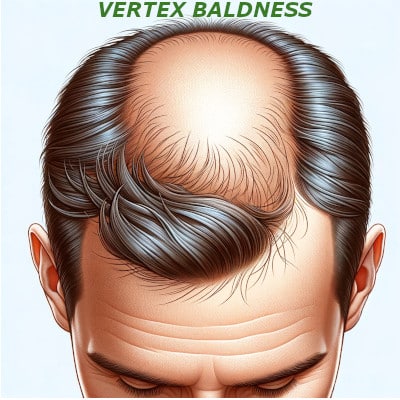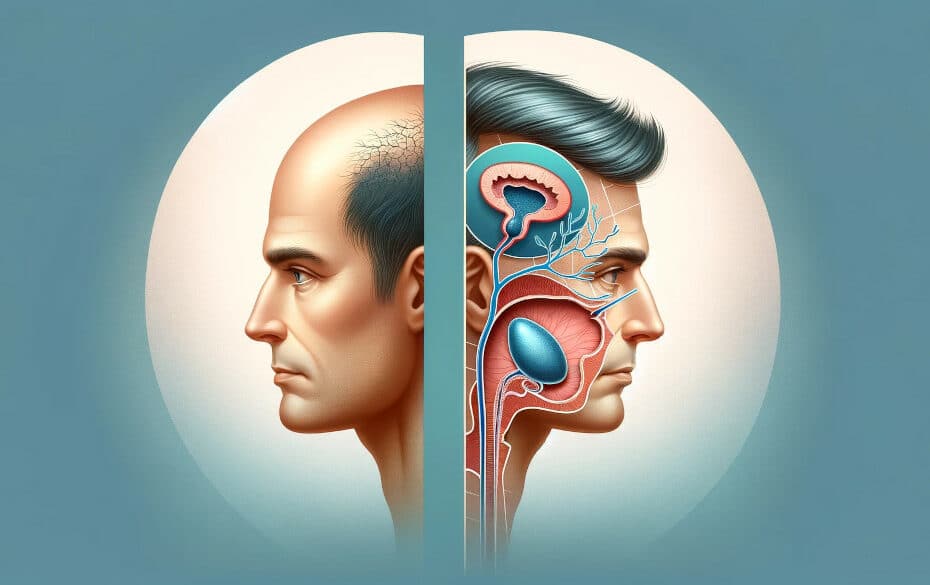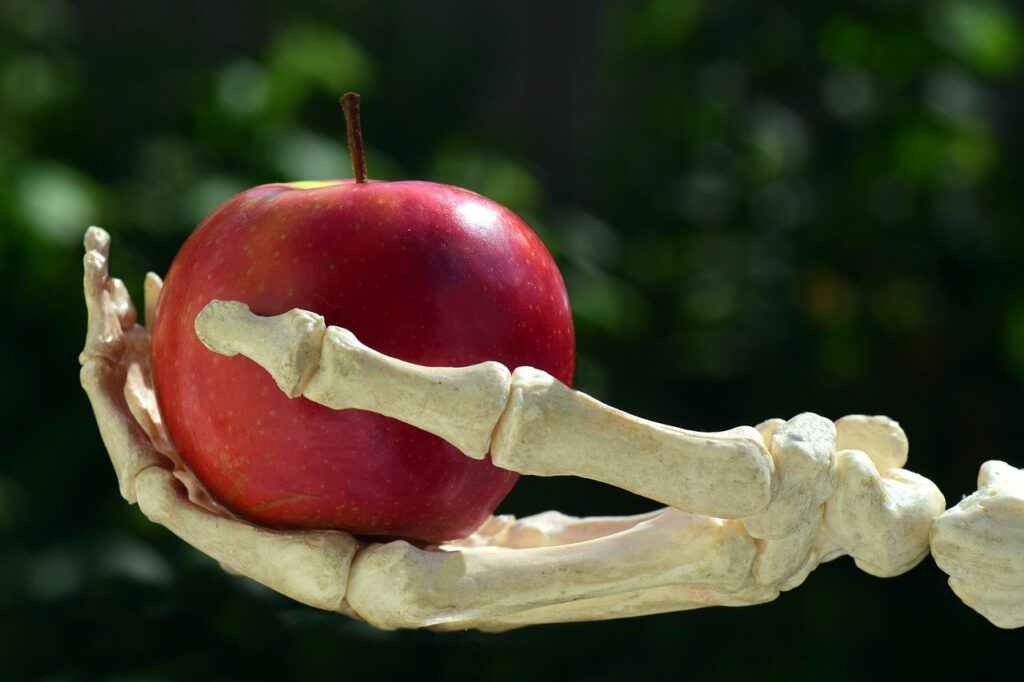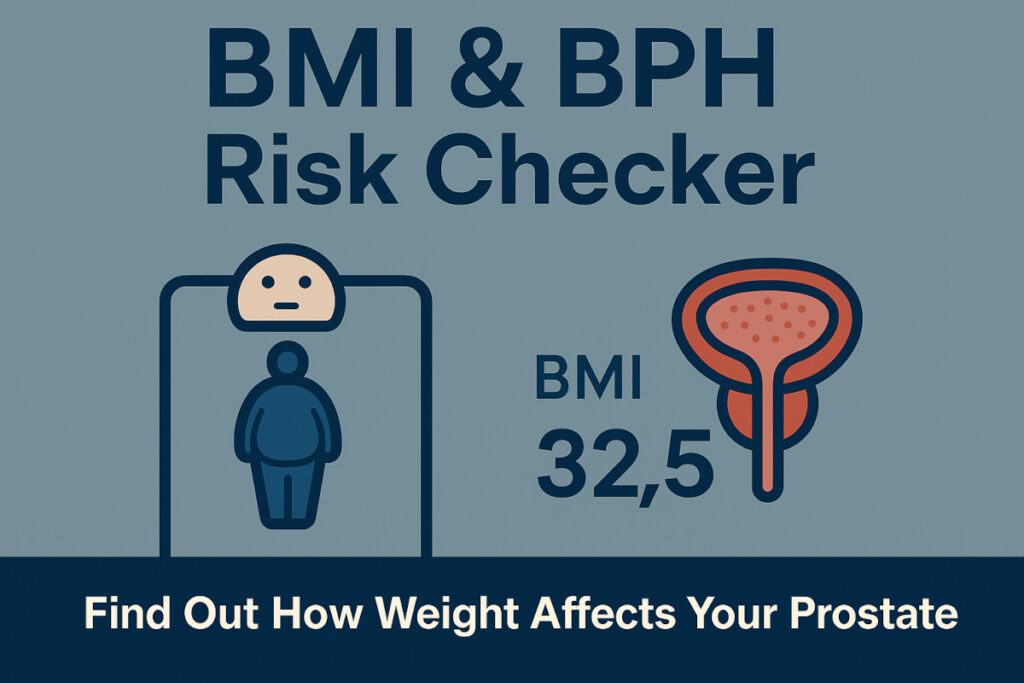Last Updated on July 7, 2024 by Max
Introduction
Have you ever considered that the state of your hair could be a window into your prostate health? Intriguing, isn’t it? Welcome to “Baldness Patterns and Prostate Health: What Men Need to Know About Cancer and BPH Risks,” where we delve into a fascinating aspect of men’s health that often flies under the radar. Here, we’re not just talking about typical age-related hair loss, but a specific pattern of baldness that recent studies have linked to significant health concerns. Imagine this: the pattern of hair thinning on your head could potentially signal more than just a change in appearance; it may be an important indicator of your prostate health.
In this post, we’re going to explore the connection between vertex baldness – hair loss at the crown of your head – and an increased risk of aggressive prostate cancer and benign prostatic hyperplasia (BPH). We’ll dissect groundbreaking research and present you with a clear picture of what these findings mean for your health. So, let’s embark on this enlightening journey together and uncover the critical insights that your hair is trying to tell you about your prostate health.
- Introduction
- Understanding Baldness Patterns
- Baldness and Its Links to Prostate Cancer
- Baldness and Benign Prostatic Hyperplasia (BPH)
- Solving the DHT Puzzle: Elevated Levels in Baldness and Natural Reduction Strategies
- Studies on Erectile Dysfunction and Male Pattern Baldness
- The Practical Implications for Men with Vertex Baldness
- Conclusion
- Call to Action
- References
Understanding Baldness Patterns
Let’s dive into the world of male pattern baldness (MPB) with a twist – did you know that even the great Julius Caesar was self-conscious about his thinning hair? Yes, one of history’s most powerful leaders was not immune to the common man’s plight of hair loss. He famously tried to conceal his balding head with a laurel wreath. Talk about ancient comb-overs! Now, while Caesar might have been more concerned about his appearance than his prostate health, his baldness saga sets the stage for our modern understanding of male pattern baldness, or androgenetic alopecia.

This condition, far more than a cosmetic inconvenience experienced by emperors and everyday men alike, is marked by a receding hairline and thinning hair, particularly at the top and front of the head. It’s a complex interplay of genetics and hormones, with dihydrotestosterone (DHT), a testosterone derivative, playing a leading role. But our focus is on a specific chapter of this story: vertex baldness. This pattern, unlike the laurel-wreath-hiding hair woes of Caesar, targets the crown of the head, creating a distinctive horseshoe pattern. It’s not just a visual cue; recent research suggests it could be a red flag for prostate health issues.
While vertex baldness is under our microscope, let’s not forget other patterns like the uniform thinning across the scalp or the pronounced baldness at the temples. Each pattern has its narrative and impact on health, but so far, only vertex baldness has been spotlighted in the context of prostate health. Understanding these patterns is crucial, and not just for finding the right hairstyle or headwear à la Caesar. It’s about decoding the messages our bodies are sending us. So, as we unravel the connections between baldness patterns and prostate health, remember: each strand, present or absent, is part of a larger story about our well-being. Stay tuned for more insights!
Baldness and Its Links to Prostate Cancer
The plot thickens when we explore the relationship between baldness and prostate cancer. A pivotal study published in the Journal of Clinical Oncology sheds light on this connection (Journal of Clinical Oncology, 2014). Here’s the crux: Men with moderate baldness at the front and crown of their head by age 45 were found to have up to a 40% higher risk of developing aggressive prostate cancer compared to their non-balding counterparts. This finding was a significant leap in understanding how external markers like hair patterns can reflect internal health risks.
The question arises, what links hair follicles on the forehead and top of the head to the prostate, especially its peripheral zone where cancer usually develops? Research points towards genetic changes, particularly in a gene called Maspin, a tumor suppressor gene. When the Maspin gene is disabled in mice, they develop bald spots and early prostate cancer. This suggests a potential genetic pathway shared by hair follicles and prostate cancer cells, though the exact mechanisms remain under investigation. This connection is especially crucial for men who develop baldness in their twenties and thirties. It suggests that prostate cancer screening may need to start earlier for these men, as they are at a higher risk of developing higher Gleason-grade cancer.
Furthermore, a Canadian study supports these findings, indicating that early male pattern baldness is a strong and independent risk factor for prostate cancer, with a higher degree of baldness correlating with an increased risk of higher-grade prostate cancer. These findings underline the importance of considering hair loss patterns as potential indicators of prostate health, especially in younger men, and suggest that more personalized screening strategies might be beneficial.

But why specifically vertex baldness? This pattern, as mentioned, involves thinning or loss of hair at the crown of the head. The study highlighted that this particular form of baldness was the key indicator linked to a heightened prostate cancer risk. Other patterns of baldness did not demonstrate a similar increase in risk, pinpointing the uniqueness of vertex baldness in this context.
The question now is, how are these two seemingly disparate conditions – hair loss and prostate cancer – connected? The answer may lie in the realm of hormones, particularly testosterone and its derivatives like DHT. These androgens play a significant role in both hair growth and prostate health. The hypothesis is that men with a higher sensitivity to these hormones may be more prone to both vertex baldness and aggressive prostate cancer. It’s a complex interplay of genetics, hormones, and possibly other environmental factors that culminate in this surprising correlation.
This discovery is not just a curious medical coincidence; it’s a crucial insight. Men exhibiting vertex baldness, especially at a younger age need to be more vigilant about their prostate health. It underscores the importance of regular check-ups and monitoring for prostate cancer, especially as one age. So, as we connect the dots between the top of the head and the health of the prostate, remember: the story your hair is telling may be more significant than you think.
Baldness and Benign Prostatic Hyperplasia (BPH)
Benign Prostatic Hyperplasia (BPH) is a common condition as men age, characterized by the enlargement of the prostate gland. This enlargement can lead to symptoms like increased urinary frequency, difficulty in starting and stopping urination, a weak urine stream, and waking up frequently at night to urinate. While these symptoms can be bothersome, BPH is generally not life-threatening.
Interestingly, there’s a link between male pattern baldness (MPB) and BPH. A comprehensive meta-analysis involving 17 studies with 68,448 participants found that MPB is associated with an increased risk of BPH (Odds Ratio = 1.26; 95% CI: 1.05-1.51; P = 0.01) (PubMed, 2018). This association indicates that men with MPB, particularly those with vertex baldness, may also need to be more cautious about symptoms of BPH. Another study involving 225 patients with BPH and 160 controls over 60 years of age demonstrated a strong association between BPH and MPB. Patients with BPH had a higher grade of male pattern baldness compared to controls (median value of grade IV versus III), and a greater frequency of inherited baldness was noted in the BPH group than in the controls.
The underlying link between MPB and BPH may be attributed to the pathogenesis of an androgen-dependent disorder. Both conditions are influenced by dihydrotestosterone (DHT), a potent form of testosterone, which plays a role in hair loss and prostate tissue growth. However, the exact mechanisms remain under investigation, and more studies are needed to fully understand this relationship.
But why this connection? It’s speculated that the same hormonal factors, particularly DHT, which is implicated in MPB, also play a role in the development of BPH. DHT is known to stimulate prostate growth, which can potentially lead to BPH. Additionally, genetic factors may be at play, given the overlapping genetic influences observed in both conditions. This correlation underscores the importance of monitoring urinary symptoms in men with MPB, especially as they age. While more research is needed to fully understand and confirm these links, the current evidence suggests a noteworthy relationship between the top of the head and the health of the prostate.
Solving the DHT Puzzle: Elevated Levels in Baldness and Natural Reduction Strategies
A study indicates that men with male pattern baldness (MPB) generally have higher production rates of DHT. In this study, the mean production rates of DHT in young men with MPB were significantly higher than those in healthy men (60 ± 50 microg/h vs. 17.8 ± 6.2 microg/h). This suggests a direct link between elevated DHT levels and baldness. Excess DHT levels are linked to male pattern baldness as DHT causes hair follicles to shrink, shortening the hair’s growth period and lengthening the rest period.
The question is how to slow down this process. Several natural remedies have been identified that may help reduce DHT levels:
- Saw Palmetto: Known to inhibit the enzyme 5-alpha reductase, which converts testosterone into DHT.
- Stinging Nettle: Traditionally used for BPH, it may reduce DHT levels in tissues.
- Pumpkin Seed Oil: Shows potential in improving scalp hair count and reducing DHT levels.
- Lycopene: Found in tomatoes and other red fruits, it may control DHT levels and has a role in reducing prostate enlargement.
- Pygeum: Extracted from the bark of the American Cherry tree, it is known to alleviate symptoms associated with prostate enlargement and reduce DHT.
- Green Tea: Contains polyphenols like EGCG that can antagonize androgen receptors and inhibit 5-alpha reductase.
- Fenugreek: Known to decrease DHT levels while increasing testosterone levels.
- Caffeine: Though not extremely potent, it can block androgen receptors and stimulate follicle hair growth.
Studies on Erectile Dysfunction and Male Pattern Baldness
There is a common belief that bald men may have higher levels of testosterone and, by extension, maybe more sexually potent or active. However, this belief is not supported by scientific evidence. Research indicates that male pattern baldness and testosterone are not directly linked. High levels of testosterone do not cause hair loss. Instead, it’s the DHT hormone, derived from testosterone, that is the main triggering factor for baldness. Testosterone levels in bald men are normal when compared to those who are not bald. Therefore, the idea that men with progressive baldness, who may have higher DHT levels, are more sexually potent or active is not supported by current scientific understanding. The relationship between baldness, DHT, and sexual potency is more complex and not directly correlated as commonly assumed.
About 5-10% of testosterone in adults converts to dihydrotestosterone (DHT) each day. This conversion primarily occurs in peripheral tissues like the skin, prostate, and hair follicles. It’s catalyzed by the enzyme 5α-reductase, which has two main relevant isoforms, types 1 and 2 (Strut Health, Cleveland Clinic, NCBI, Sage Journals, TestosteroneReplacement.org).
5-alpha-reductase inhibitors block the action of 5-alpha-reductase, thus preventing the conversion of testosterone into DHT. Two main inhibitors are finasteride, which inhibits type 2 5-alpha-reductase, and dutasteride, which inhibits both types 1 and 2. These drugs are used in treating male pattern hair loss and benign prostatic hyperplasia (BPH), and they may reduce the risk of prostate cancer (Drugs.com).
Some studies indicate an association between the use of 5-alpha-reductase inhibitors for male pattern hair loss and adverse sexual and reproductive side effects, including erectile dysfunction (ED), decreased ejaculate volume, decreased libido, and infertility (PubMed). However, a comprehensive review concluded that 5-alpha-reductase inhibitors do not lead to erectile dysfunction to a significant degree and that dihydrotestosterone is less relevant than testosterone in erectile function (PubMed). Other research states that there is no direct relationship between male pattern baldness and ED (Justinboey).
In summary, while there’s evidence suggesting some connection between the treatment for male pattern baldness (especially using 5-alpha-reductase inhibitors) and erectile dysfunction, the direct relationship between male pattern baldness itself and ED is less clear.
The Practical Implications for Men with Vertex Baldness
If you’re a man with vertex baldness, you’re not just carrying a unique hair pattern; you might also be carrying a higher risk for specific health issues. Remember that study from the Journal of Clinical Oncology (2014)? It’s not just a scientific curiosity but a wake-up call. If you’re experiencing hair loss at the crown of your head, it’s time to tune in more closely to your body, particularly your prostate health.
The Critical Importance of Regular Health Screenings and Prostate Check-ups
Here’s the deal: Early detection can be a game changer in the world of prostate health. Prostate cancer, if caught early, can often be managed effectively. So, men with vertex baldness, consider this a friendly nudge to get regular prostate screenings, especially as you age. And don’t forget, your doctor is your ally in this journey. Discussions about prostate-specific antigen (PSA) tests and other screenings can help catch any issues early on.
Lifestyle and Health Tips for Prostate Health
Now, let’s talk lifestyle. You might be wondering, “Can I do something to improve my prostate health?” Absolutely! Here are some quick, actionable tips:
- Exercise Regularly: Physical activity isn’t just good for your heart; it’s great for your prostate too. A study in the Journal of Urology (2015) found that physical activity, particularly vigorous exercise, is linked to a reduced risk of BPH and urinary tract symptoms.
- Eat a Prostate-Friendly Diet: Foods rich in antioxidants, like tomatoes (hello, lycopene!), green tea, and cruciferous vegetables, are great. Also, consider reducing red meat and high-fat dairy products as suggested by some studies like the one in the American Journal of Clinical Nutrition (2010).
- Watch Your Weight: Obesity is a risk factor for BPH and prostate cancer, as reported in a study in Cancer Prevention Research (2013). Keeping a healthy weight through diet and exercise is key.
- Stay Hydrated, but Mind Your Fluid Intake at Night: Drinking enough water is essential, but try to reduce fluid intake in the evening to avoid frequent night-time trips to the bathroom.
- Limit Alcohol and Caffeine: These can irritate your prostate, so moderation is the mantra here.
- Quit Smoking: Smoking is linked to an increased risk of prostate cancer, as per research in the British Journal of Cancer (2011).
- Stress Management: Chronic stress can exacerbate symptoms of BPH, according to a study in Urology (2017). Techniques like mindfulness and yoga can be beneficial.
Remember, these tips are not just for men with baldness concerns; they’re great practices for all men to consider for their overall health. Your lifestyle choices play a significant role in your health journey, so take charge and make mindful decisions.
Final Thoughts
Gentlemen, whether you’re sporting a full head of hair, a classic vertex baldness pattern, or anything in between, your hair might be more than a style statement. It could give you valuable information about your health. Embrace regular check-ups, maintain a healthy lifestyle, and stay informed. After all, knowledge is power, especially when it comes to your health.
Conclusion
As we wrap up our insightful journey through the world of baldness patterns and their link to prostate health, let’s take a moment to recap the key points we’ve uncovered: We’ve delved into the fascinating correlation between vertex baldness and an increased risk of aggressive prostate cancer, as well as benign prostatic hyperplasia (BPH). Remember, the crown of your head is telling you more than just your hair story. The intersection of genetics, hormones (especially DHT), and environmental factors plays a crucial role in both male pattern baldness and prostate health. It’s a complex web that science is still solving. A balanced diet, regular exercise, and a healthy lifestyle aren’t just good for overall well-being; they’re particularly beneficial for prostate health. These proactive steps can make a significant difference.
Call to Action
Now, we turn to you, our readers. This isn’t just a conversation; it’s a call to action. If you or someone you know is experiencing vertex baldness, consider it more than a cosmetic change. Use this knowledge as a prompt for a health check-up. Share this information with friends and family; it might just be the nudge they need for a timely prostate health screening.
And we’re not just here to inform; we’re here to engage. Do you have experiences, questions, or insights about the link between baldness and prostate health? Your stories and queries enrich this conversation. Drop a comment below, share your thoughts, and let’s continue this crucial dialogue. Together, let’s raise awareness and take steps towards a healthier future.
References
- Jin T, Wu T, Luo Z, Duan X, Deng S, Tang Y. Association between male pattern baldness and prostate disease: A meta-analysis. Urol Oncol. 2018 Feb;36(2):80.e7-80.e15. doi: 10.1016/j.urolonc.2017.09.022. Epub 2017 Oct 18. PMID: 29054497.
- Vierhapper H, Nowotny P, Maier H, Waldhäusl W. Production rates of dihydrotestosterone in healthy men and women and in men with male pattern baldness: determination by stable isotope/dilution and mass spectrometry. J Clin Endocrinol Metab. 2001 Dec;86(12):5762-4. doi: 10.1210/jcem.86.12.8078. PMID: 11739436.
- Ben’s Natural Health (n.d.): “How To Reduce DHT Levels Naturally.”
- DrFormulas (n.d.): “Is DHT the Cause of Male Pattern Baldness?”.
- Prostate Cancer Foundation. “Fallout from New Study: Men with Early Balding May Be at Higher Risk of Aggressive Prostate Cancer.”
- Papa NP, MacInnis RJ, English DR, Bolton D, Davis ID, Lawrentschuk N, Millar JL, Severi G, Hopper JL, Giles GG. Early-onset baldness and the risk of aggressive prostate cancer: findings from a case-control study. Cancer Causes Control. 2018 Jan;29(1):93-102. doi: 10.1007/s10552-017-0981-0. Epub 2017 Nov 14. PMID: 29139043.
- Journal of Clinical Oncology (2014): Study on the Association between Early Male Pattern Balding and Aggressive Prostate Cancer. This study found a significant correlation between vertex baldness and an increased risk of aggressive prostate cancer.
- Journal of Urology (2015): Research highlighting the benefits of physical activity, particularly vigorous exercise, in reducing the risk of benign prostatic hyperplasia (BPH) and urinary tract symptoms.
- American Journal of Clinical Nutrition (2010): Study discussing the impact of diet, particularly the consumption of red meat and high-fat dairy products, on prostate health.
- Cancer Prevention Research (2013): Research emphasizing the link between obesity and an increased risk of BPH and prostate cancer.
- British Journal of Cancer (2011): Study exploring the relationship between smoking and an increased risk of prostate cancer.
- Urology (2017): Research on the effects of chronic stress on the symptoms of benign prostatic hyperplasia.








This article provides a detailed exploration of the intriguing connection between male pattern baldness, specifically vertex baldness, and prostate health. The correlation between the two raises important questions about the potential use of baldness patterns as indicators for health risks.
Do you think the awareness of the potential link between vertex baldness and prostate health could lead to changes in healthcare practices, such as earlier and more personalised screenings for men with specific baldness patterns?
Thank you for your comprehensive article.
Hi Starlight,
Thank you for your comment. The potential link between vertex baldness and prostate health is indeed a compelling area of study. While it’s too early to definitively say whether this awareness will lead to changes in healthcare practices, it does open the door for more targeted research and potentially more personalized screening approaches in the future. As research evolves, it could inform new guidelines for earlier and more tailored screenings, especially for individuals at higher risk due to specific patterns of baldness.
Warm regards,
Makhsud
Thank you for providing such comprehensive information on the link between baldness patterns and prostate health. As someone who has witnessed the impact of prostate cancer in my family, I am particularly interested in understanding more about the preventive aspects discussed in your article. Are there specific lifestyle changes or interventions that individuals with a family history of prostate cancer, like myself, can adopt to reduce the associated risks? I believe sharing personal experiences and insights can greatly benefit others navigating similar concerns.
Looking forward to hearing your feedback,
Jono
Hi Jono,
Thank you for your thoughtful comment. Understanding the link between baldness patterns, prostate cancer, and BPH is indeed crucial, especially with a personal connection to the topic. As for preventive measures, focusing on a healthy diet, regular exercise, and regular medical check-ups can be beneficial. Since family history is a significant factor, it’s wise to discuss personalized preventive strategies with a healthcare provider. For a more comprehensive analysis of cancer risk factors and a personalized assessment, I invite you to visit this post on prostate cancer risk factors. You’ll find detailed information and can take our Risk Assessment Quiz to evaluate your own risk level.
Warm regards,
Makhsud
Thank you for this informative article on the connection between baldness patterns and prostate health. It’s intriguing to learn that vertex baldness, unlike other patterns of baldness, may indicate a higher risk of aggressive prostate cancer and BPH. This insight is particularly valuable as it underscores the importance of prostate health screenings, especially for those with vertex baldness. Articles like this play a crucial role in raising awareness about health issues that are often overlooked. Are there any studies that link other patterns of baldness to prostate issues?
Hi Troy,
I’m glad you found the article informative. Regarding your question, most research, including the studies referenced in the article, primarily focuses on the link between vertex baldness and prostate health. Other patterns of baldness haven’t shown the same level of association in studies so far. However, remember that regular health screenings are crucial regardless of hair patterns.
Warm regards,
Makhsud
Really interesting article! I had no idea that there was a potential link between baldness patterns and prostate health. It’s fascinating to learn how these seemingly unrelated aspects of a man’s health could be connected. This information is definitely valuable for men who are trying to understand their own health risks better. However, I’m curious about the extent to which lifestyle factors might also play a role in this relationship. For instance, do diet, exercise, or stress levels have any significant impact on the correlation between baldness patterns and prostate health? I’d love to hear more about how these lifestyle choices might interact with the genetic factors discussed in the article. Thanks for sharing this important information!
Hi Corey,
I’m glad you found the article insightful! Indeed, the relationship between baldness patterns and prostate health is a complex one. While the article mainly discusses genetic factors, lifestyle choices like diet, exercise, and stress management do play significant roles in overall health, including prostate health. Research suggests that a balanced diet, regular exercise, and effective stress management can contribute to better health outcomes. These factors may not directly influence the genetic aspects of baldness and prostate health, but they are essential for maintaining overall well-being.
Warm regards,
Makhsud
You provided me with new information that I was not aware of. I never knew that baldness could be linked to my prostrate health before reading your article.
I liked how you provided healthy options that I could try. You see, I prefer to go with natural health products before man-made medications.
The lifestyle changes are very helpful. I do plan to make some of the changes that you recommend in your article. I am not experiencing baldness and I am happy about that. Being over 60 I am concerned about my prostate health.
Just to let you know I am going to share your post to my family and my friends to read.
Hi Jeff,
It’s great to hear that you found the information on the link between baldness and prostate health useful and that you’re considering natural health options and lifestyle changes. I’m glad the article could provide actionable advice for your health concerns. Sharing this knowledge with your family and friends is a wonderful idea, as it spreads awareness and potentially helps others too.
Warm regards,
Makhsud
Hi there, I had no idea that balding was linked to prostate cancer. I’m 31 with no signs of balding yet. A few grays, but no balding. Are grays a sign of anything besides stress?
I will have to keep an eye on my hair as I continue to get older. It could be an early indicated that could help you get a jump on cancer. So, this information can come in handy for sure!
Hi Conner,
I’m glad the article shed light for you on the potential link between baldness and prostate health. Regarding graying hair, it’s generally considered a normal part of aging and not directly linked to prostate health. While keeping an eye on changes in your hair as you age is wise, remember that these are just potential indicators. Regular health check-ups are the best way to monitor your prostate health and catch any issues early.
Warm regards,
Makhsud
Well that certainly was an eye-opener. fantastic information for all the men out there and written in a way that made me want to keep reading!! Who would have thought baldness or certain types of baldness and prostate cancer could be linked… The remedy and lifestyle suggestions here are a helpful touch and spot on. This is such a great article it needs to be shared with as many people, particularly men. Big wake up call for some!! Keep up the great work on here.
Hi Ryan,
Thank you for your encouraging words! I’m glad to know the article was engaging and provided valuable information. It’s great to hear that you found the lifestyle and remedy suggestions helpful. Sharing the article to raise awareness about these important health topics is a fantastic idea, as it can indeed serve as a wake-up call for many. Your support and feedback are greatly appreciated!
Warm regards,
Makhsud